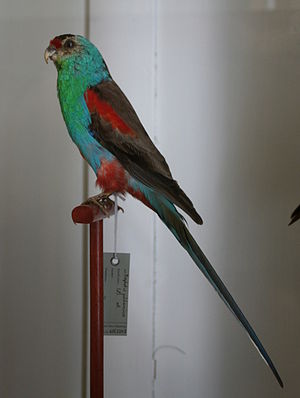Paradise Parakeet
| Paradise Parakeet | ||||||||||||
|---|---|---|---|---|---|---|---|---|---|---|---|---|

prepared male Paradise Parakeet; State Museum for Nature and Man , Oldenburg |
||||||||||||
| Systematics | ||||||||||||
|
||||||||||||
| Scientific name | ||||||||||||
| Psephotus pulcherrimus | ||||||||||||
| ( Gould , 1845) |
The Paradise Parakeet ( Psephotus pulcherrimus ) is a parakeet from the family of real parrots (Psittacidae) and is considered extinct. It was common in the grasslands on the border between Queensland and New South Wales in Australia . It used to be quite common within its small area of distribution. The last living bird was seen in 1927.
To this day, reports keep cropping up that Paradise Parakeets would still exist. This is sometimes also evidenced by photos. However, it is mostly a cross between the golden-shouldered parakeet and the multi-colored parakeet . The mixed breeds show a certain similarity to Paradise Parakeets.
Appearance
The Paradise Parakeet reached a height of 27 centimeters and was an unusually multi-feathered parakeet. Their plumage was a mixture of turquoise, blue, scarlet, black, and brown, and the tail was the same length as the body. As for singing parakeets characteristic was a sexual dimorphism, which was not pronounced as with the two closely related red-rumped parrot species Golden-shouldered parrot and black cap parakeet . While the male's forehead was bright red, the female's forehead and eye area were yellowish-buff. Overall, the female had a more brownish plumage, but shared several plumage characteristics with the male. The parting of her head was also dark and both sexes had a red patch on the shoulder. The Parakeet's flight was fast and only slightly undulating. It was probably very much like the golden-shouldered parakeet's flight.
behavior
Paradise parakeets lived in pairs or in small family groups. Breeding records for this parakeet species are available from September, December and March. Paradise parakeets were cave breeders who usually built their nesting holes in a native termite burrow. More rarely, caves were dug in a sandy bank embankment. No nesting material was entered. The clutch, consisting of three to five eggs, was laid on the ground.
Causes of the decline in stocks
There is no ultimate clarity about the causes of its sudden population decline. However, it is attributed to overgrazing, clearing of land, hunting by bird trappers as well as to a higher hunting pressure from introduced higher mammals such as cats . The ornithologist Joseph M. Forshaw , who specializes in Australian parrots, cites the disappearance of native grasses, the seeds of which the Paradise Parakeets almost exclusively feed, and the rapid spread of Opuntia vulgaris as a result of the colonization of this part of Australia as the main reason for the decline in the population European settlers. The Paradise Parakeet is a prime example of a species that is unable to adapt to sudden changes in its habitat or to evade them. By the end of the 19th century the Paradise Parakeet was already a very rare bird; as early as 1915 it was thought to be extinct. With a targeted search for individuals of this species, some birds could still be observed. The public reacted very enthusiastically to the press request to take part in the search for the Paradise Parakeet. The sightings received were, however, all false reports, especially poorly identified blood-bellied parakeets . The last confirmed sighting of this bird species took place on September 14, 1927.
supporting documents
literature
- Joseph M. Forshaw : Australian Parrots. 1st German-language edition. Volume 2, Arndt-Verlag, Bretten 2003, ISBN 3-9808245-2-7 .
- Penny Olsen : Glimpses of Paradise: The Quest for the Beautiful Parrakeet. 2007.
- Errol Fuller : Lost Animals - Extinction and the photographic record. 2013.
- Joseph M. Forshaw: Vanished and Vanishing Parrots. 2017.
Web links
- Psephotellus pulcherrimus in the endangered Red List species the IUCN 2008. Posted by: BirdLife International, 2008. Accessed January 31 of 2009.
